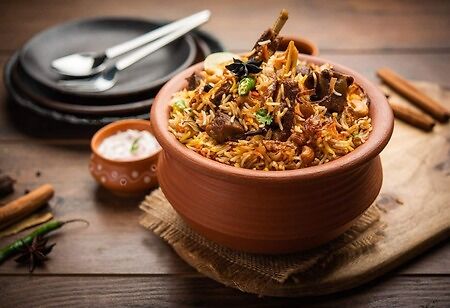
The Story of How Persian Cultural Food Became India's Favorite Cuisine


All of us have our own favorite cuisines. For me, just the word 'biryani' is enough to have my mouth watering. I know; it’s not just me, but the majorities of Indians who eat meat are huge fans of biryani and eat it whenever they can. According to Zomato and Swiggy, biryani has become one of the most-ordered dishes in India over the last two years. New delivery operations and restaurants dedicated to biryani keep opening. On social media, the discussions about biryani are never-ending. Which biryani has the most fans anyway? Malabar Biryani or Lucknowi Biryani? Is there such a thing as vegetarian biryani? Let us begin with the cultural history of biryani.
History of Biryani
The Persian Empire was one of the most powerful empires in the world, located in the southwestern province. Now Iran, the empire was known for its vast culture. The cuisine of Persia has a long history where it is still cherished—and biriyani is one among them.
During the Mughal invasion of India, they brought not only terror but also biriyani. The Persian word birian, which means fried rice, is the source of the English word biryani. The dish is thought to have originated in Esfahan. It is typically consumed in Iran with Nan-e-Taftun, a sort of bread.
According to Larousse Gastronomique, an encyclopedia of gastronomy, biryani is a Persian-inspired dish from North India. The original meat was lamb or mutton, but you may also use chicken or fish. Prawns (shrimps) are popular in the west, and chana dal may be added. The spiced cooked meat mixture is layered with basmati rice flavored with saffron, turmeric, and black cardamom and frequently enhanced with raisins and almonds. The Biriani is then cooked in a pot with a tight lid, and ghee or milk may be added. Biryanis can be garnished with the edible silver leaf when served for special events.
However, the history of biryani’s creation is likewise up for debate. One of the well-known tales is the one involving Mumtaz Mahal, Shah Jahan’s consort. When Mumtaz Mahal allegedly went to the army barracks, she believed that the men needed to eat more nutrient-dense cuisine. She, therefore, gave the chefs the order to feed the soldiers rice and beef. However, the most widely known explanation is that biryani originated in Persia.
Here are the best Five Varieties of Biryanis in India:
Hyderabadi Biryani
There are two varieties of Hyderabadi Biryani: Pakki (cooked) and Kacchi, both of which are thought to have originated in the Nizam of Hyderabad’s kitchen (raw). Basmati rice and meat are cooked separately and then layered in the Pakki Hyderabadi Biryani. While the kacchi Hyderabadi Biryani is made with layers of raw marinated meat (chicken or lamb) sandwiched between layers of basmati rice flavored with saffron, onions, and dried fruits, both are simmered over charcoal in an earthen pot with dough sealing the lid. The result is a rich, fragrant, and punchy biryani. Most likely, if you go out to eat with a local, you will end up ordering one of the Hyderabadi biryani varieties.
Lucknowi Biryani
The Lucknowi Biryani, also referred to as the Awadhi biryani, is distinctive due to its dum pukht cooking method. Saffron, star anise, and cinnamon are used to flavor the rice, which is partially cooked separately from the spice-infused beef (or chicken). Then, the meat and rice are piled and stewed for hours in a handi (deep-bottomed dish) to bring out the flavors. The finished dish is a tender, mild Lucknowi biryani.
Calcutta Biryani
Although the Awadhi type biryani of Lucknow is where the genesis of Kolkata’s Calcutta Biryani can be found, it has roots in Lucknow. It is prepared with light yellow rice, then layered with meat based on yogurt, soft-boiled eggs, and potatoes. It is characterized by mild flavors with a hint of sweetness and a more sparing use of spices. Saffron, nutmeg, and kewra can be added as well, giving the biryani a comforting scent.
Thalassery Biryani
This biryani, which is flavor-rich and spicy, is from Kerala in the Malabar region. In this region, there are as many and various types of biryani as there are civilizations and ethnic groups. For instance, the Thalassery Biryani uses Kaima or Jeera Rice, an indigenous strain of rice, rather than the customary basmati rice. This biryani also has pork or chicken, fried onions, fennel seeds, sautéed cashews, raisins, and Malabar spices. When serving, the meat and Kaima are only combined after the Kaima has been cooked separately.
Bombay Biryani
The trip to Mumbai is worthwhile for the Bombay Biryani. Its particularly sweet, tangy, and aromatic flavor comes from the combination of dried plums, kewra water (screw pine), chicken (or mutton or veggies), fried and seasoned potatoes, and several other ingredients.
How Profitable is Biryani Selling Hotels in India?
Indians love briyani. Hence, there will be a large market for any biriyani maker. Naturally, there will be a lot of demand for all kinds of biriyanis in major cities like Bangalore and Bombay. The food business is booming in India and offers the finest future prospects and opportunities with an overall growth rate of 30-35 percent. Biriyani is vital to this growth.